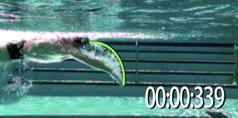Courtesy of Gary Hall Sr., 10-time World Record Holder, 3-time Olympian, 1976 Olympic Games US Flagbearer and The Race Club co-founder.
The following is an excerpt from our forthcoming book entitled Fundamentals of Fast Swimming
Once the hand enters the water directly in front of the swimmer’s shoulder, the area we call the front quadrant, the period of time until the hand actually starts moving backwards in the water generating propulsion is referred to as the lift phase. The duration of the lift phase is quite varied, depending on the freestyle technique being utilized. With hip-driven freestyle and a stroke rate of around 60 per second, or a 2 second cycle time, the duration of the lift phase is greater than .6 seconds. With shoulder-driven freestyle at a stroke rate of 120, or a 1 second cycle time, the duration of the lift phase is less than .3 seconds. During the lift phase, the hand should move forward and downward, just inside the elbow, but not backward, inward (commonly referred to as an in-sweep) or outward (commonly referred to as in out-sweep).
When observing the motion of the hand from the side during the freestyle swim, imagine an underwater clock which is about two feet in diameter with the top of the clock positioned at the surface of the water. While the arm is longer than two feet, the diameter of the clock is only two feet because as the hand moves around the clock face through the underwater pulling motion, starting at 12 o’clock, the swimmer is simultaneously moving forward. Consequently, by the time the arm completes its underwater pull, the hand moves only about 2 feet from front to back, relative to the water.
As you look at the clock face, 12 o’clock is precisely where the swimmer enters the hand in the water. If the swimmer is moving from left to right, during the lift phase, the hand moves forward and downward along the perimeter of the clock until it reaches 3 o’clock on the face. In freestyle, because of anatomical constraints, the hand must move downward considerably before it moves backward. That is the end of the lift phase. From that point, the hand begins moving backward and downward along the perimeter toward 6 o’clock and begins generating propulsion.

Gary Sr. spends .34 seconds in the lift phase of his right pull, using shoulder driven freestyle with a 100 stroke rate.
The two primary forces that occur during the lift phase are lift and frontal drag. In general, lift forces, which elevate the swimmer’s body more into the air and out of the water, have the benefit of reducing frontal drag. Just as with a boat, the higher in the water and closer a swimmer can get to hydroplaning, the better. Since it is estimated that in order to hydroplane, a human body needs to achieve a speed of nearly 15 mph, and world record speed in the 50-meter sprint is currently just over 5 mph, we will not be seeing any swimmer hydroplaning soon.
Yours in swimming,
Gary Sr.
Like The Race Club on Facebook
Follow The Race Club on Instagram
Follow The Race Club on Twitter
Connect to The Race Club / Gary Hall Sr. on Linkedin
THE RACE CLUB
Because Life is Worth Swimming, our mission is to promote swimming through sport, lifelong enjoyment, and good health benefits. Our objective is for each member of and each participant in The Race Club to improve his or her swimming performances, health, and self-esteem through our educational programs, services and creativity. We strive to help each member of The Race Club overcome challenges and reach his or her individual life goals.
The Race Club provides facilities, coaching, training, technical instruction, video, fitness and health programs for swimmers of all ages and abilities. Race Club swim camps are designed and tailored to satisfy each swimmer’s needs, whether one is trying to reach the Olympic Games or simply improve one’s fitness. Our programs are suitable for beginner swimmers, pleasure swimmers, fitness swimmers, USA swimming or YMCA swimmers, or triathletes; anyone who wants to improve swimming skills. All of our Race Club members share an enjoyment of being in the water and use swimming to stimulate a more active mind and body.




